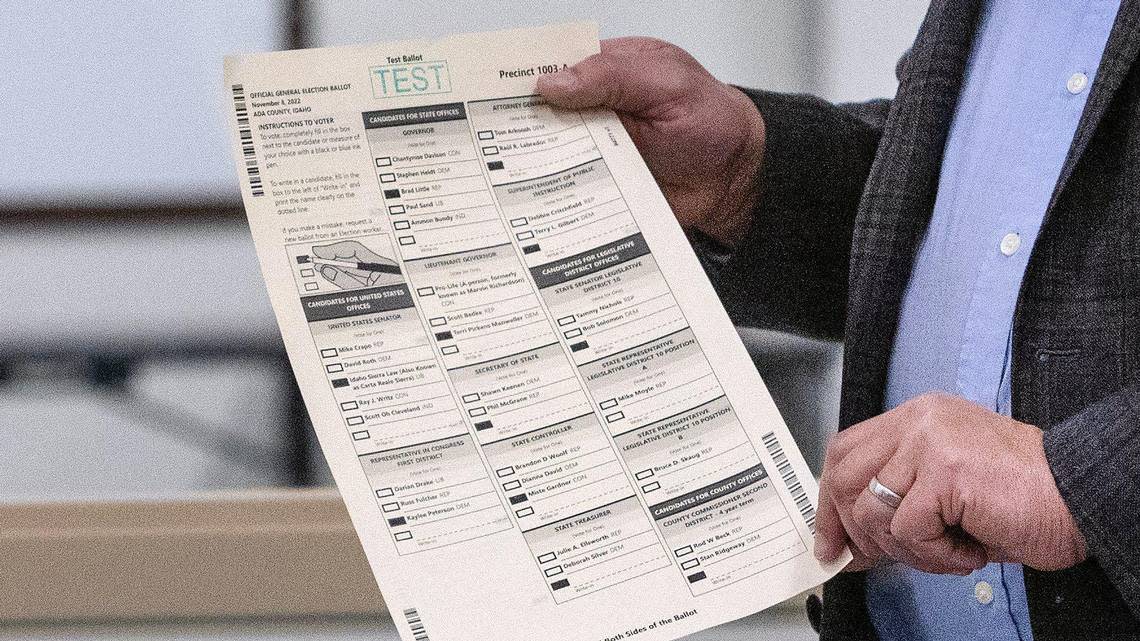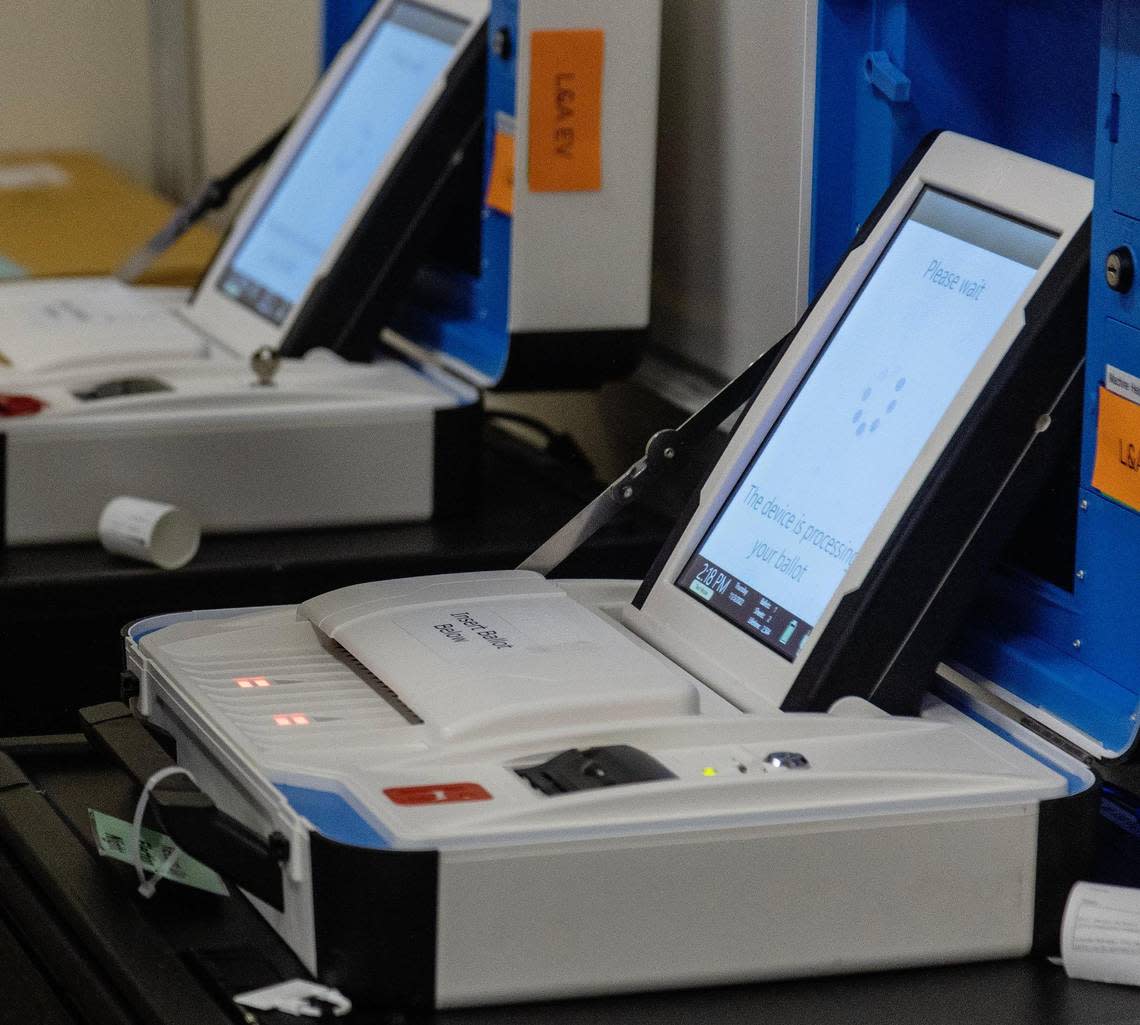How Idaho election officials say they’ll keep midterm ballots safe, election secure
On Thursday, Ada County elections officials invited the public to watch them run an accuracy test on voting machines. Among the attendees were several faces familiar to Ada County Clerk Phil McGrane, a candidate on Tuesday’s ballot for secretary of state.
“Some people I recognize, because we’ve given tours to them,” McGrane told the Idaho Statesman at the event. “There’s been groups that have had a lot of questions, so we’ve shown them around the facility. We’ve definitely seen an uptick in that and an uptick in people sending us inquiries.”
The number of inquiries about election security over the last two years has been unprecedented, according to McGrane.
That’s not surprising in a state where one in three Idaho adults believes widespread voter fraud took place in the 2020 U.S. election and former Republican President Donald Trump was the real winner, according to poll results commissioned by the Idaho Statesman.
In response to election misinformation, the Secretary of State’s Office launch a 40-part video series last year explaining how the Idaho election system worked. Deputy Secretary of State Chad Houck believes refusal to accept election results comes partly from lack of understanding.
“When you don’t understand the why, it’s that much more likely that you’re going to be willing to doubt or have confusion that lends itself to voters having a lower level of confidence in the outcome of the election,” Houck told the Idaho Statesman in a phone interview.
Here are seven beliefs Idaho elections officials say are flat-out-wrong, and why.

1. Idaho saw widespread election fraud in the 2020 election.
The most prominent spreader of Idaho election fraud allegations was MyPillow CEO Mike Lindell. While official results showed that 63.8% of Idaho votes went to former President Donald Trump, Lindell alleged that presidential election results across the state were electronically manipulated to switch 35,357 votes from Trump to Joe Biden.
In response to Lindell’s widely circulated allegations, the Idaho Secretary of State’s Office conducted an election audit. It chose three counties, Butte, Camas and Bonner, to see if Lindell’s claims had merit. The recounts yielded a 0.1% disparity between the original tallies and the recounts, which didn’t affect the election results.
2. Absentee and mail-in ballots aren’t secure.
First widely used during the Civil War to allow military members to vote while away from home, voting by mail is a practice that has flourished ever since and is part of a separate security process in Idaho.
Election officials say workers time-stamp the envelope of absentee and mail-in ballots as soon as they receive them. Using a digital voter index, workers then verify that the voters’ signatures on the envelopes match the ones on their registration cards.
Those ballots are kept in a locked storage area until they are ready to be counted.
3. Voting machines can’t be trusted.
Idaho officials say the state has many layers of security when it comes to voting machines. The electronic tabulating machines cannot be connected to the internet, including through Bluetooth.
Logic and accuracy tests are conducted before each election, in which filled-out test ballots are fed through the machines to verify accurate results.
Last week, Ada County ran 432 ballots through voting machines during the public logic and accuracy test. The ballots were filled out with specific results in mind by election officials to see if the the machine would accurately produce the same numbers.
Officials then locked the machines in a room with video surveillance until Election Day. A new code is generated each time the machines are used. If the same code is displayed onscreen when they are unlocked, officials say they will know no one tampered with them.
Houck said one of the most important checks on the electronic system in Idaho is the paper ballot. If a machine’s results are ever questioned, the paper ballots can be hand-counted in an audit.
4. It’s easy to vote using a dead person’s name.
Every month, the Idaho Health and Welfare Department is required to send the Secretary of State’s Office a list of everyone who has died in the last month. As required by law, the office finds where the deceased individuals were registered to vote and alerts the relevant county clerks, who must remove those names from their eligible voter rolls, confirmed Houck.
5. It’s easy to vote in more than one place.
Idaho‘s statewide voter registration system, established through the Help America Vote Act of 2002, allows election officials to easily keep track of voters who move within the state, according to the Secretary of State’s Office website. For example, someone may move from Ada County to Canyon County. But once the person registers in Ada County, the person will be automatically removed from the Canyon County voter list, preventing them from voting in both.
When someone moves from another state, that person must register to vote in Idaho and prove residency before casting a ballot. The newcomer must also provide the previous state of residence. Idaho then notifies the previous home state so the voter can be removed from that state’s eligibility list.
Cases of “voter impersonation, non-citizen voting, double voting, and other types of voter fraud are rare,” according to the Idaho Administration and Elections Office website, with “nearly all” suspected voter fraud incidents turning out to be “mistakes rather than cases of intentional fraud.”
Houck did not know how many cases of confirmed voter fraud took place in Idaho in 2020. He said counties initially self-reported 49 suspected incidents. He believes that number likely dropped once counties began to investigate them further.
Houck recalled a 2020 case where someone reported a woman for voting a second time. She appeared to return and register under the same date of birth and address as before, with only with a slightly different name. But after an investigation, it turned out they were twin sisters.

6. No one will notice if the ballot box is stuffed with fake ballots.
Each ballot has unique markings, which vary from county to county, to ensure it can’t be duplicated. Ballots typically are printed with a special ink that will scan or photograph as a different color from the original, according to Houck.
But if someone did manage to bypass those safeguards, Idaho keeps careful track of the number of ballots printed for each precinct, according to Idaho law. These records would make it easy to tell if more ballots were turned in than were printed.
7. Political parties and candidates have no way to monitor election procedures.
Political parties and candidates can request one poll watcher per precinct, and parties can request up one poll challenger per precinct, to oversee the election process.
Poll challengers observe the sign-in and registration process, and challenge whether a person is eligible to vote. Poll watchers can observe a polling location and ballot count process to ensure that everything is happening by the book.





